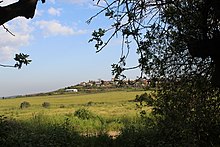
Back موشاف Arabic Moixav Catalan Mošav Czech Moshav Welsh Moschav German Moŝavo Esperanto Moshav Spanish Moshav Basque موشاو Persian Mošav Finnish





A moshav (Hebrew: מוֹשָׁב, plural מוֹשָׁבִים moshavim, lit. "settlement, village") is a type of Israeli village or town or Jewish settlement, in particular a type of cooperative agricultural community of individual farms pioneered by the Labour Zionists between 1904 and 1914, during what is known as the second wave of aliyah.[1] A resident or a member of a moshav can be called a "moshavnik" (מוֹשַׁבְנִיק). There is an umbrella organization, the Moshavim Movement.
The moshavim are similar to kibbutzim with an emphasis on community labour.[2] They were designed as part of the Zionist state-building programme following the green revolution Yishuv (Hebrew for 'settlement') in the British Mandate of Palestine during the early 20th century, but in contrast to the collective farming kibbutzim, farms in a moshav tended to be individually owned but of fixed and equal size. Workers produced crops and other goods on their properties through individual or pooled labour with the profit and foodstuffs going to provide for themselves. Moshavim are governed by an elected council (Hebrew: ועד, romanized: va'ad, lit. 'committee'). Community projects and facilities were financed by a special tax (Hebrew: מס ועד, romanized: mas va'ad, lit. 'committee tax'). This tax was equal for all households of the community.
- ^ Sofer, Michael; Applebaum, Levia (1 July 2006). "The rural space in Israel in search of renewed identity: The case of the moshav". Journal of Rural Studies. 22 (3): 323–336. doi:10.1016/j.jrurstud.2005.10.004. ISSN 0743-0167.
- ^ Sofer, Michael (December 2005). "The future of family farming in Israel: the second generation in the Moshav". The Geographical Journal. 171 (4): 357–368. Bibcode:2005GeogJ.171..357S. doi:10.1111/j.1475-4959.2005.00171.x. ISSN 0016-7398.
© MMXXIII Rich X Search. We shall prevail. All rights reserved. Rich X Search